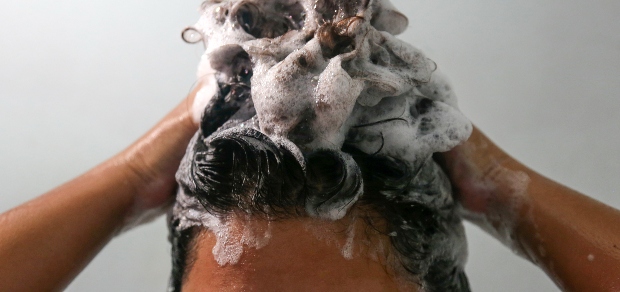
Seborrheic Dermatitis and Psoriasis: How to Tell the Difference
There are many possible conditions that can make skin dry, red, and flaky. Two common conditions that may look alike but are quite different are psoriasis and seborrheic dermatitis. Here, we discuss the causes of these conditions, how to tell them apart, and what to do if you have either—or both.
What Are Seborrheic Dermatitis and Psoriasis, Exactly?
“Seborrheic Dermatitis is a very common condition that presents as dryness, scaling, and flaking of the scalp,” says Ife Rodney, M.D., a board-certified dermatologist and dermatopathologist at Eternal Dermatology + Aesthetics in Fulton, Maryland. Seborrheic dermatitis can also show up on the face, Rodney says. The appearance may closely resemble psoriasis, which also appears in the same areas. However, psoriasis is an auto-inflammatory condition, in which the body overproduces skin cells.
“A main difference lies in the fact that psoriasis is a systemic condition, meaning that it can also affect our bodies internally,” Rodney explains. Psoriasis has been linked to multiple comorbidities, such as obesity, cardiovascular disease (like heart disease and stroke), diabetes, and depression. Also, people with psoriasis may develop psoriatic arthritis, which presents as red, swollen, tender joints, usually on the fingers and toes.
On the other hand, seborrheic dermatitis presents with cosmetic discomfort on the face or along the hairline; it doesn’t impact patients internally, Rodney says. Seborrheic dermatitis is caused by an overabundance of a fungus called Malassezia furfur, says Scott Paviol, M.D., a board-certified dermatologist at Paviol Dermatology in Charlotte, North Carolina.
“This fungus normally lives on your scalp, but when in excess, it causes skin cells to multiply more quickly than usual and excess oil builds up,” he explains. “That excess oil causes skin cells to accumulate and the scalp sheds more than usual. The white or yellow scales then flake off and cause dandruff.”
Paviol said there are a handful of factors that can cause Malassezia to multiply, including:
- Increasing age
- Genetic predisposition
- Changes in hormones
- Stress
- Not washing your hair frequently enough
Know that “frequently enough” is a time span that can vary widely depending on a person’s skin. For example, some people find that once a week is enough; whereas, others need to wash their hair daily.
Telltale Differences in Symptoms
Both conditions can present as dry, itchy, red, scaly areas on the skin of the face and scalp. Psoriasis tends to have thick, plate-like, silvery scales. Whereas, seborrheic dermatitis usually has finer, greasier, yellowy-white scaling, says Rodney.
Seborrheic dermatitis tends to appear on the face, scalp, and chest, usually in oily areas of the skin. “Psoriasis is usually more distressing as it affects sensitive areas like the elbows, knees, buttocks, and belly-button areas,” says Rodney.
Getting Diagnosed
Whether you have seborrheic dermatitis or psoriasis, you deserve a diagnosis and treatment plan that will help you get back to a place of comfort in your own skin. The good news is that there are treatments available for both of these conditions.
In fact, some people discover they have an overlap of both seborrheic dermatitis and psoriasis called sebopsoriasis.
In order to determine the best treatment plan for you, it’s important to see a physician who can first help you get properly diagnosed.
“Once you have a diagnosis, you can have a treatment plan that is specific and tailored to your needs with appropriate follow-up,” Paviol says. “It is very important to get an accurate diagnosis because, in the case of psoriasis, you may need to be evaluated to see if you have joint involvement” and be monitored for life for other comorbidities.
Rodney agrees, adding that your initial appointment will likely be a skin evaluation, maybe even with a skin test, such as a skin scraping or skin biopsy, to help the doctor get to a proper diagnosis.
From there, you and your doctor can work together to establish a treatment plan.
How Do Treatments Differ?
“Some of the treatments for seborrheic dermatitis and psoriasis are similar,” says Rodney, noting that this can be especially true for more mild psoriasis cases. The most common treatments include medicated anti-fungal shampoos (such as ciclopirox, ketoconazole, pyrithione zinc, or selenium sulfide shampoo) and corticosteroid or calcineurin inhibitor lotions or creams for the face or scalp, which help suppress the inflammation.”
But if you’ve tried those treatments thinking you have seborrheic dermatitis and they haven’t helped, you may actually have psoriasis and need more aggressive treatments, she says. In that case, treatment might have to involve systemic oral medications or biologic medications to help calm your immune system.
Living with Psoriasis or Seborrheic Dermatitis
One similarity between these conditions is that they can flare up at times of stress or when there are changes in your environment. “You will want to have the tools and plan in place for when you may flare again,” says Rodney.
Regardless of which condition they have, Rodney encourages people to be kind to themselves and to establish relationships with medical professionals who can help.
“It’s important to realize that both these conditions can affect our physical appearance and health, as well as our mental and emotional well‑being,” she says. “There’s no need to suffer in silence, trying to solve the problem yourself. Reach out to your dermatologist so we can get your skin under control.”
Know that there is help available and no reason to endure discomfort and embarrassment. Instead of trying to diagnose and treat yourself, see a dermatologist who can help your symptoms improve.
You May Also Like:
Want to Read More?
Access all of Twill Care’s content, community, and experts for free!
Already a member? Login
Want to Read More?
Access all of Twill Care’s content, community, and experts for free!
sign UP For FreeAlready a member? Login

